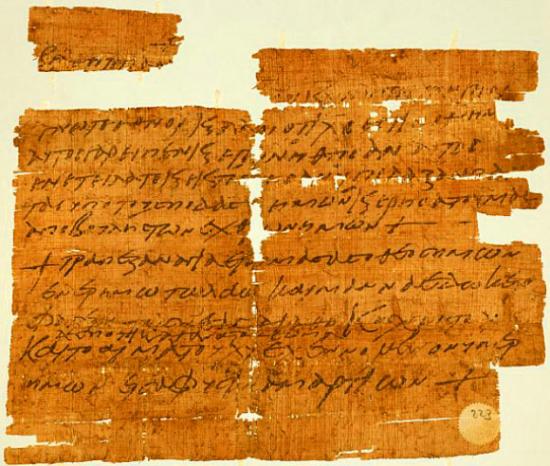Source -http://www.sci-news.com/archaeology/science-last-supper-papyrus-early-christianity-02133.html
Dr Roberta Mazza at the University of Manchester’s John Rylands Research Institute has discovered what she says is the world’s oldest surviving document to use the Christian Eucharist liturgy as a protective charm. The intriguing papyrus document from Roman Egypt, which appears to be nearly 1,500 years old and refers to the Last Supper and ‘manna from heaven,’ casts new light on early Christianity – just 300 years after the Roman emperor Constantine converted to the religion.

1,500-year-old ‘Last Supper’ papyrus from Egypt. Image credit: Roberta Mazza / University of Manchester.
The Greek text of the papyrus – an original combination of biblical passages including Psalm 78:23-24 and Matthew 26:28-30 among others – reads:
“Fear you all who rule over the Earth.
Know you nations and peoples that Christ is our God.
For he spoke and they came to being, he commanded and they were created; he put everything under our feet and delivered us from the wish of our enemies.
Our God prepared a sacred table in the desert for the people and gave manna of the new covenant to eat, the Lord’s immortal body and the blood of Christ poured for us in remission of sins.”
The papyrus was originally found in Egypt in the 19th century, and is currently housed at the John Rylands Library in Manchester.
It shows how Christians adopted the ancient Egyptian practice of wearing amulets to protect the wearer against dangers. This practice of writing charms on pieces of papyrus was continued by the Christians who replaced the prayers to Egyptian and Greco-Roman gods with extracts from the Bible.
“To this day, Christians use passages from the Bible as protective charms so our ‘amulet’ marks the start of an important trend in Christianity,” Dr Mazza said.
“Though we know almost nothing about its owner, we think it could have been owned by a resident of the village nearby Hermopolis (el-Ashmunein). We can say this is an incredibly rare example of Christianity and the Bible becoming meaningful to ordinary people – not just priests and the elite.”
Dr Mazza added: “thanks to this discovery, we now think that the knowledge of the Bible was more embedded in 6th century CE Egypt than we previously realized.”
The scientist also discovered that the papyrus was written on an ancient version of recycled paper by using cutting-edge spectral imaging techniques.
Faint lettering on its back is thought to be a receipt for the payment of grain tax which was certified by the tax collector from the village of Tertembuthis – this is in the countryside of the ancient city of Hermopolis (modern el-Ashmunein).
“The amulet maker would have cut a piece of the receipt, written the charm on the other side and then he would have folded the papyrus to be kept in a locket or pendant. It is for this reason the tax receipt on the exterior was damaged and faded away,” said Dr Mazza, who announced the discovery on 4 September at a conference entitled ‘From Egypt to Manchester: Unravelling the John Rylands Papyrus Collection.’
Roberta Mazza. Unravelling the Rylands Papyri: Results of the Pilot Project.Conference ‘From Egypt to Manchester: Unravelling the John Rylands Papyrus Collection.’ Manchester, UK; 4-6 September, 2014